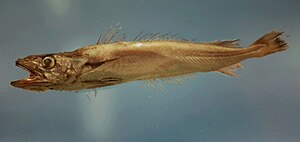Merluccius albidus
| Merluccius albidus | ||||||||||||
|---|---|---|---|---|---|---|---|---|---|---|---|---|

Merluccius albidus |
||||||||||||
| Systematics | ||||||||||||
|
||||||||||||
| Scientific name | ||||||||||||
| Merluccius albidus | ||||||||||||
| ( Mitchill , 1818) |
Merluccius albidus is one of 15 species of the genus hake ( Merluccius ). It occurs in the western central Atlantic.
features
The fish is generally silver and white, has a hard ray in its dorsal fin and 45 to 51 soft rays, the anal fin has 35 to 41 soft rays. The head as well as the mouth of the fish are quite long and large. They reach a maximum body length of 70 centimeters, but usually males are 30 centimeters and females 45 centimeters long.
distribution
Merluccius albidus is in the western Atlantic from Nova Scotia , south along the US coastline in the entire Gulf of Mexico , except for the northwestern Cuba , in the Caribbean from Puerto Rico and along the Central and South American coast of Mexico until after French Guiana spread . Its full range of depths is between 80 and 1170 meters, but it is most commonly between 160 and 640 meters. It is quite common throughout the range, but three main components that live separately from each other can be located: one in the northern Atlantic, one in the northern Gulf of Mexico and a third in the southern Gulf of Mexico and the Caribbean. The exact distribution of the distribution is difficult to determine because the fish are often on the continental shelf and cannot be caught by trawls.
Way of life
This fish lives primarily near the bottom on the continental shelf in the upper parts of the slope. At night they go to shallower waters to feed. Juvenile fish feed primarily on crustaceans, other small fish and shrimp, adult fish on small fish such as lantern fish, sardines and anchovies and, in rare cases, on crustaceans and octopus. Small Merluccius albidus can prey on the American anglerfish ( Lophius americanus ).
Reproduction
Little information is available on the reproductive biology of Merluccius albidus , they spawn at depths of 3 to 550 meters near the ground, twice a year from April to July in New England and from late spring to early autumn in the Gulf of Mexico and the Caribbean Sea . The eggs can swim in the sea and are transparent and have an oil globule. The size of the eggs differs, 0.99 to 1.18 millimeters or 1.04 to 1.24 millimeters depending on the literature. Hatching takes place after 6 to 8 days at a temperature of 8.9 to 10.6 ° C. In this state, the larvae are 3 to 3.8 millimeters long. The larvae grow rapidly up to the third year of life, with a male specimen of 26.5 centimeters reaching half of their maturity and females with a length of 30.1 centimeters. At the age of 5, female fish also live an average of 2 years longer than their male counterparts; they usually reach an age of 3 years.
Danger
This species of fish has little interest in fishing, it is mostly caught as bycatch of Merluccius bilinearis and sold fresh, frozen and smoked commercially at the market. Exact catch rates do not exist as these fish are often confused with Merluccius bilinearis and thus both are verified as one species. Because this fish is so widespread, abundant and has no known threats, it is classified as not endangered by the International Union for Conservation of Nature (IUCN) .
Web links
supporting documents
- ↑ a b Cobitis albidus on Fishbase.org (English)
- ↑ a b c d e Merluccius albidus in the Red List of Threatened Species of the IUCN 2017-2. Posted by: McEachran, JD, Polanco Fernandez, A. & Russell, B, 2013-01-29.
- ↑ a b Sukwoo Chang, Peter L. Berrien, Donna L. Johnson, and Christine A. Zetlin: Essential Fish Habitat Source Document: Offshore Hake, Merluccius albidus, Life History and Habitat Characteristics NOAA Technical Memorandum NMFS-NE-130, September 1999 ( Pp. 1–5. ( Memento of the original from May 17, 2017 in the Internet Archive ) Info: The archive link has been inserted automatically and has not yet been checked. Please check the original and archive link according to the instructions and then remove this notice. ).
